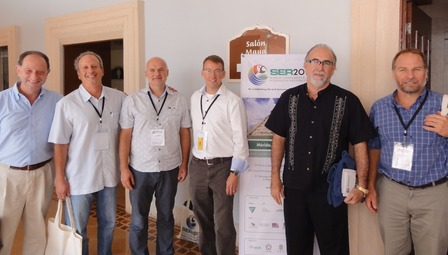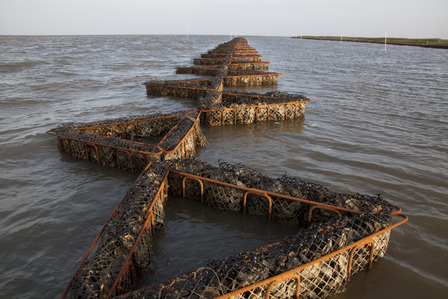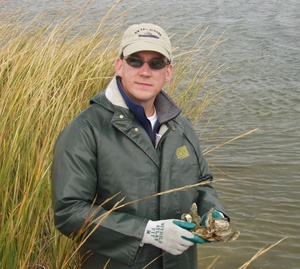|
ISSC preparing Best Management Practices for
shellfish restoration projects
A global study
estimated that some 85% of oyster reef habitat has been lost globally (Beck et al., 2011).
In the U.S., where oyster reefs are in poor condition or even functionally
extinct in many bays, restoration of bivalve populations and their associated
structured habitat has risen as a priority for many local, state and federal
agencies in recent years, as well as the conservation community in general.
Indeed, oyster reefs are one of five priority habitats for NOAA’s Restoration
Center, and a National Shellfish Initiative is currently being launched that
will bring public and private resources to bear on research that will help to
improve the health of the Nation’s shellfish resources as well as technical
support for an expanding shellfish aquaculture industry. Not only is
the pace of restoration increasing in the U.S., but the scale of restoration
efforts has increased as well through funding initiatives like the American
Recovery and Reinvestment Act (“Recovery Act”). In 2009, NOAA provided Recovery Act
funding to support five large oyster reef habitat restoration projects in
Virginia, North Carolina, Florida, Alabama and Louisiana.
For conservation organizations, the impetus for restoring bivalves and their
associated habitat is the suite ecological services that bivalve reefs and
beds provide. Many projects are initiated to address the loss of
structured reef habitat in estuaries, since field studies have demonstrated
that restored oyster reef habitat can enhance local populations of
commercially and recreationally important species of fish and crabs (Peterson
et al. 2003; Grabowski and Peterson 2007). Other projects involving
oysters, as well as infaunal bivalves like hard clams, are intended to
increase the filtration capacity in estuaries and to increase grazing
pressure on excess phytoplankton or harmful algae (Cerrato et al.
2004). Recent field studies have shown that oyster reefs also provide a
significant denitrification service, just as other kinds of coastal wetlands
do, and can export nitrogen from estuaries (Piehler and Smyth 2011).
Lastly, restoration projects are being implemented as a bio-engineering
approach to protecting shorelines and obtaining additional services such as
fish production that traditional engineering solutions cannot provide
(Scyphers et al. 2011).
One of the important considerations when designing a restoration project
involving bivalves is the intersection between public and environmental
health. This is particularly important when proposing projects that
occur in waters where shellfish harvesting is not permitted, either because
the waters are contaminated or because they are ‘uncertified’ (i.e., not
necessarily polluted, but have not been monitored sufficiently well to assign
a condition or ‘classification’ for shellfish harvest purposes). Some areas
around the U.S. that fall into this category are not particularly conducive
to restoration (i.e., the ecological conditions do not support shellfish or
the populations are not in need of restoration). Other such areas, however,
are both ecologically conducive and there is strong public interest in
regaining lost ecosystem services through restoration. In these areas,
there is a clear need to ensure that restoration projects are designed to
both achieve their ecological goals, as well as to ensure that the potential
for human health impacts are minimized.
Conservation groups and industry representatives alike seem to be in
agreement that restoration of bivalves and reef habitat is an important
endeavor. A survey of the East Coast Shellfish Growers Association
revealed, for example, that 86% believe that leaving shellfish in the water
(e.g., within sanctuaries) promotes natural selection and helps to increase
disease resistance in local bivalve populations. Eighty percent of
growers would like to be directly involved in shellfish restoration projects
and, particularly noteworthy, 67% support restoration projects in closed
waters (ECSGA 2011). Dr. Bob Rheault, Executive Director of the
Association, puts these results in context, “While many of our members are
wary of potential illnesses associated with shellfish restoration in closed
waters, a clear majority (67%) still support these projects. Over the past
year, the ECSGA board of directors has developed a formal restoration policy
that reflects this concern while emphasizing the benefits that these projects
bring. The Association supports these projects under the condition that
strong education and enforcement programs are in place to engender
stewardship in the public and minimize the risk of illegal harvest.”
For their part, public management agencies are, of course, obligated to
ensure that both public health and the nation’s waters and ecosystems are
protected and in doing so, they protect the shellfish industry as well.
A project that illustrates how this can work in practice was highlighted in a
previous issue of the Clamor (October
2009). Texas Parks and Wildlife Department (TPWD) is using reef
restoration specifically to enhance habitat for redfish and sea trout in the
southern portion of Galveston Bay. The project was implemented in
waters that were closed to harvest and was designed to complement other
restoration efforts elsewhere in the Bay that are designed to enhance the
oyster fishery. Property owners adjacent to the project site suspended
bags of shell from their piers to catch spat for eventual transplanting to
the nearby reefs, which served to increase awareness about the purpose of the
reefs and create a sense of local stewardship.
To help with designing restoration projects that account for both environmental
and public health considerations, the Interstate Shellfish Sanitation
Commission (ISSC) is developing a set of Best Management Practices
(BMPs). Dr. Boze Hancock, Coordinator of TNC’s National Partnership
with NOAA’s Community-based Restoration Program, notes “These BMPs are the
result of extensive research and dialog over the past year involving agency
representatives, industry members and conservation practitioners alike.
Once approved, the BMPs should help to increase the communication among all stakeholders
and ensure that projects have well designed implementation plans that include
not only include biological considerations, but social aspects as
well.” The ISSC will be reviewing the BMPs Report in their October 2011
meeting in Seattle, Washington.
References:
Beck, M.W., R.D. Brumbaugh, L. Airoldi, A. Carranza, L.D. Coen, C. Crawford,
O. Defeo, G. Edgar, B. Hancock, M. Kay, H. Lenihan, M. Luckenbach, C.
Toropova, G. Zhang and X Guo.2011.
Oyster reefs at risk and recommendations for ecosystem revitalization. Bioscience 61: 107-116.
Cerrato, R.M., D.A. Caron, D.J. Lonsdale, J.M. Rose and R.A. Schaffner. 2004.
Effect of the northern quahog Mercenaria
mercenaria on the development of blooms of the brown tide alga Aureococcus anophagefferens.
Mar. Ecol Prog. Ser. 281: 93-108.
Grabowski, J.H. and C.H. Peterson. 2007. Restoring oyster reefs to recover
ecosystem services. In: Cuddington K., Byers JE, Wilson WG, Hastings A (eds).
Ecosystem engineers: concepts, theory and applications. Elsevier-Academic
Press, Amsterdam, P. 281-298.
Peterson, C.H., J.H. Grabowski, and S. P. Powers. 2003. Estimated
enhancement of fish production resulting from restoring oyster reef habitat:
quantitative valuation. Marine
Ecology Progress Series 264:251-256.
Piehler, M.F. and A.R. Smyth. 2011. Habitat specific distinctions in
estuarine denitrification affect both ecosystem function and services.
Ecosphere 2: 1-16.
Scyphers, S.B., S.P. Powers, K.L. Heck Jr. and D. Byron. 2011. Oyster reefs
as natural breakwaters mitigate shoreline loss and facilitate
fisheries. PLoSOne 6: 1-12.
Back to top »
Global Perspectives on Shellfish Conservation and Restoration
|

|
|
Session
participants (left to right) included Omar Defeo, Mike Beck, Tom Ysebaert,
Rob Brumbaugh, Cesar Lodeiros and Boze Hancock.
Credit: Amanda Wrona, TNC.
|
An international
panel of experts presented a global perspective on shellfish conservation and
restoration at the World
Conference on Ecosystem Restoration, in Merida, Mexico.
Their presentations highlighted results of a recent global survey of oyster
reef condition, and how shellfish co-management efforts and restoration
projects in North America, South America and Europe are delivering an array
of ecosystem services including increased reef fish productivity, protection
of eroding shorelines, and enhanced opportunities for production of native
shellfish.
“Oyster reefs at risk: restoring a globally imperiled ecosystem”, Dr. Mike
Beck, The Nature Conservancy, United States
“Impacts of fisheries, governance and climate in Latin American
shellfisheries, and potential actions for restoration strategies”, Dr. Omar
Defeo, Faculdad de Ciencias, Uruguay
“Disminución de los bancos de moluscos bivalves en Venezuela: estrategias
para su restauración”, Dr. César Lodeiros, Universidad de Cumana, Venezuela
“Ecodynamic solutions for the protection of intertidal habitats: the use of
oyster reefs”, Dr. Tom Ysebaert, IMARES, Netherlands
“Achieving ecosystem scale oyster reef restoration through a National
Partnership with NOAA’s Community-based Restoration Program”, Dr. Boze
Hancock, The Nature Conservancy, United States
In the discussion that followed the presentations, a few key themes emerged:
projects should be designed with specific objectives in mind, and these
should be understood by all stakeholders; projects should be monitored over
time to allow for adaptive management and reporting on outcomes; and projects
should be designed for persistence, given anticipated changes to local and
global conditions that can affect the viability of bivalve populations and
their associated habitat.
Back to top »
Synthesis study underway design of large-scale oyster reef
restoration projects
|

|
|
Reef restoration
at a TNC ARRA site using ReefBLK(tm) technology at Coffee Island in
Portersville Bay, AL.
Credit: Beth Maynor Young ©
2010
|
Oyster reefs are one
of the most imperiled marine habitats globally
and because they provide numerous services for nature and people, including
water filtration, shoreline protection, and habitat for fish and wildlife,
the large-scale loss is cause for concern. To reverse this loss, there is
increasing interest and investment in restoring oyster reef habitat.
Oyster reefs are still in fair condition in the Gulf of Mexico, which
provides a strong impetus for both conservation of remaining reefs and
targeted restoration of degraded reefs. Projects have been implemented
at various scales across the northern Gulf of Mexico over the past decade,
using various types of hard substrate materials – recycled shell, concrete
and river rock, for example. Projects have also been implemented in various
physical configurations in locations where additional oyster reef habitat is
desired, with reef materials deployed in gabion-like cages, in shell bags, or
deployed directly onto the bottom. To ensure that past projects inform
both future restoration projects and restoration at a regional scale, there
are key scientific questions that need to be addressed. One of the most
basic and pressing questions is how well these projects have met their
original objectives over time.
The Nature Conservancy (TNC) has teamed up with the USGS Louisiana
Cooperative Fish and Wildlife Research Unit, the Louisiana State University
(LSU) School of Renewable Natural Resources (LSU Agricultural Center), and
LSU Biological Sciences to conduct a Gulf-wide assessment of restoration
project performance over time. This assessment focuses primarily on subtidal
oyster reefs constructed for fish habitat purposes and has two main
components. The first component is a comprehensive review of oyster reef
restoration projects across the northern Gulf of Mexico. The researchers have
located, mapped, and collected all available information (i.e., material
type, cost, and any available reports or monitoring data) from more than 200
oyster restoration projects Gulf-wide. The second component is a field study
where the research team is investigating, more closely, a subsample of the
identified reefs to measure a set of functional services. Specifically, the
team is comparing eight reefs of different ages and material types (oyster
shell, limestone/concrete) with eight natural reefs (control) from Texas to
Florida and is collecting data on local environmental and habitat conditions,
the composition and condition of oyster populations and nekton communities to
evaluate the development of reefs, and the provision of habitat for nekton
over time. Additionally, the research team is investigating the role of these
restored reefs in providing habitat for juvenile blue crabs. When
completed, this study will help to illustrate how different materials perform
over time and affect their ability to both support oyster populations and
associated nekton communities. The project will be completed in late 2012 and
results will be incorporated into the Gulf of Mexico Restoration Decision
Support System, to aid in designing restoration projects
across the Gulf of Mexico that provide long‐term ecosystem
benefits.
For more information, contact: Bryan Piazza (bpiazza@tnc.org)
Back to top »
Upcoming Events and Conferences
Coastal
Estuarine Research Federation (CERF) Bi-ennial Conference: “Societies,
Estuaries and Coasts: Adapting to Change”.
Daytona Beach, Florida
November 6-11, 2011
National
Shellfisheries Association (NSA) 104th Annual Conference
Seattle, Washington
March 25-29, 2012
Abstract Deadline: December 1, 2011.
Note: If you would like to contribute an article or
submit items for the "Looking Ahead" section, please contact Rob Brumbaugh.
Back to top »
Oyster Restoration Publications
and Resources
Oyster
Reefs as Natural Breakwaters Mitigate Shoreline Loss and Facilitate Fisheries
Oyster
Restoration Working Group Research and Reports
The
Practitioner’s Guide to
Shellfish Restoration: An Ecosystem Services Approach, as well as
back issues of the Shellfish Restoration
Clamor are available online.
Cool Video!
“Sink Your Shucks” Shell Recycling Program. Harte Research Institute, Texas A
& M University, Corpus Christi, Texas.
Texas
Parks and Wildlife Department’s video describing the recent oyster reef
restoration activities in Galveston Bay.
Back to top »
|







